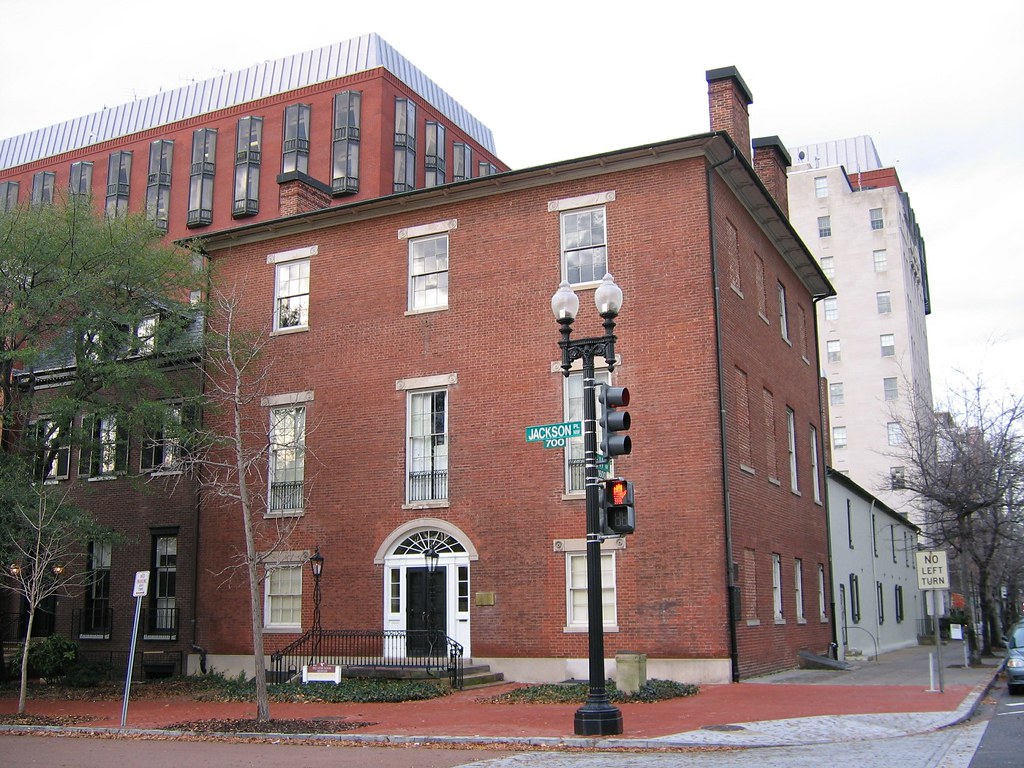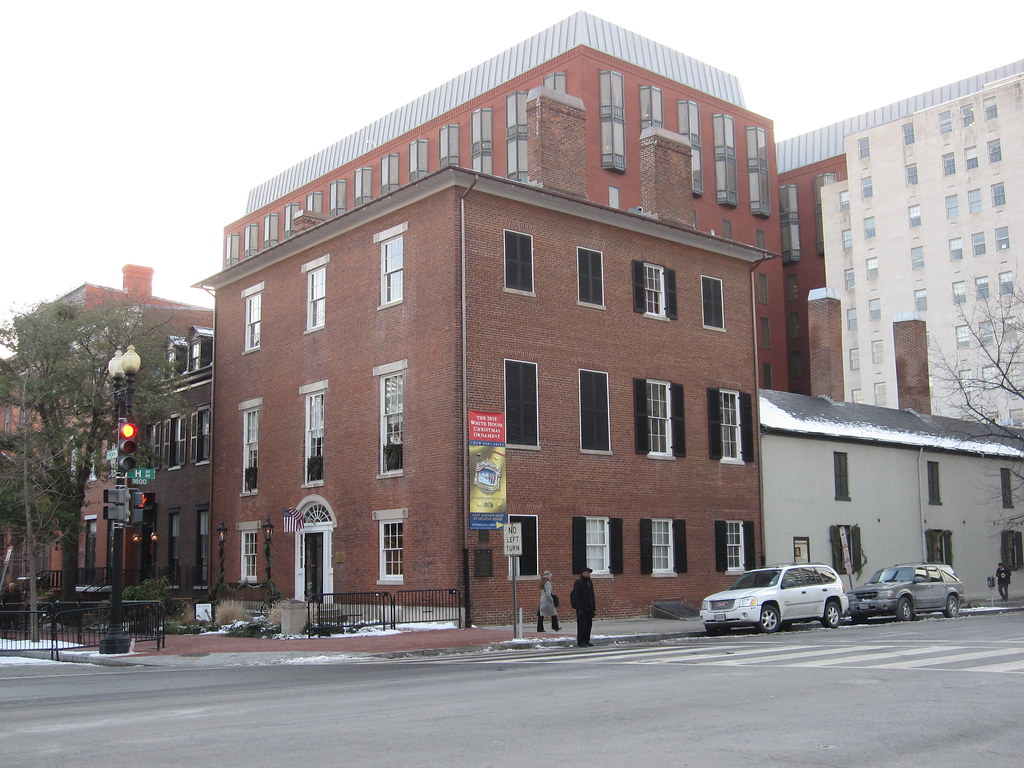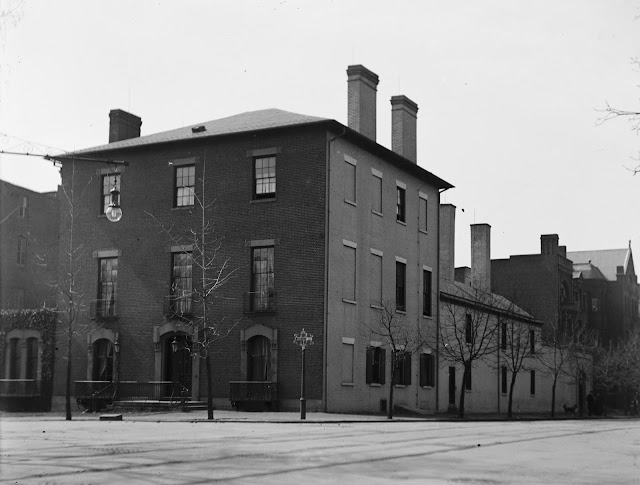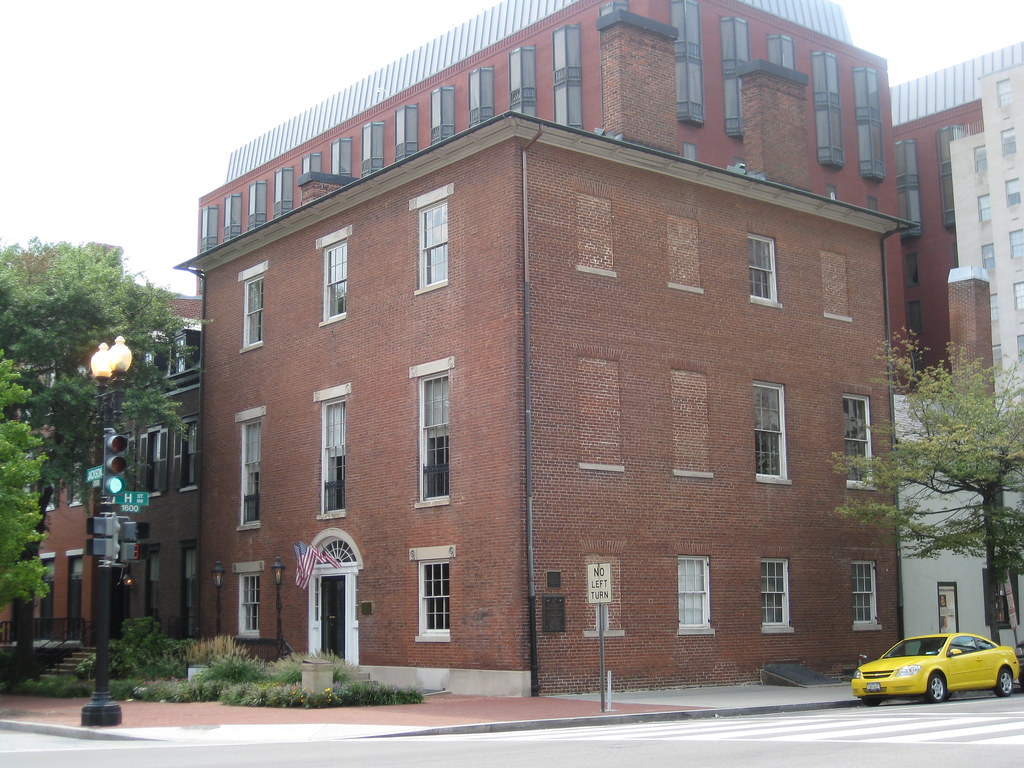One of the oldest structures in the city, Decatur House is located barely a block from the White House at the northwest corner of Lafayette Square. It became a focal point for Washington society as soon as it was constructed for naval hero
Stephen Decatur (1779-1820) in 1819. Designed for entertainment, the house has had a long career as the backdrop for both social triumph and personal tragedy.
 |
| Decatur House in 2006. Photo by the author. |
Decatur was a rock star in his day, universally celebrated for his daring naval exploits. He was fortunate to be a great naval commander during the relatively brief period in the early 19th century when military prowess at sea fired the imagination of the public as little else did. After the War of 1812, at the second inaugural ball of President James Madison, Decatur laid the battle flag of a British ship he had vanquished at the feet of Dolley Madison, another idol of the day. Having at last been appointed to Washington as a commissioner of the Navy, Decatur decided it was time to build a show house for himself and his wife Susan with the prize money he had received for his naval conquests. He bought a prominent lot on the west side of what would become Lafayette Park and commissioned architect
Benjamin Henry Latrobe (1764-1820) to design an appropriately prominent mansion. He is said to have asked for a house that would be "sturdy as a ship."
The Decatur House, as designed by Latrobe, is an architectural conundrum, both sophisticated and problematic. Latrobe is now universally acclaimed as America's first great architect, a brilliant contributor to the U.S. Capitol and the White House as well as designer of other innovative and influential buildings, including nearby
St. John's Church and many private residences. Decatur House is the only residence designed by Latrobe that is still standing in Washington. As W. Brown Morton of the National Park Service has pointed out in the building's
National Register listing, the exterior of the house is actually somewhat flawed, particularly on the H Street side, where six "blind" (bricked-up) windows look so awkward that through the years people have felt the need to make up stories about why they are there (more about that later). Nevertheless, the rooms are masterfully laid out and demonstrate Latrobe's extraordinary skill at creating flowing, elegant interior spaces. A striking, lozenge-shaped front entrance vestibule leads to a graceful staircase at the rear of the house that brings guests up to grand parlors on the second floor. As a vehicle for social levees in 1819, this place was second to none.
Decatur would have little more than a year to live in this beautiful new house, for he had become entangled in a fatal dispute with a fellow commander, James Barron (1768-1851). Barron had had the bad luck back in 1807 to be captain of the frigate
Chesapeake when it was attacked and boarded by the British, who seized four of its American crew who were allegedly British deserters. The incident was deeply humiliating to Americans, and Barron was faulted for being unprepared to respond to it more forcefully. Decatur, no great friend of Barron's to begin with, served as a member of the board of inquiry that suspended Barron from naval service for five years as punishment for mishandling the encounter. Barron then went off to Europe to wait out his exile, which happened to finish in 1813, right in the middle of the War of 1812. At that time he was summoned back urgently to active duty but failed to return to the States until after the war had ended. It was only then that he requested his old job back, much to the irritation of his former colleagues, including Decatur, who had fought so valiantly against the British. Decatur badmouthed Barron, who caught wind of it from a colleague eager to fan the flames of enmity between them, and Barron then confronted Decatur in a series of letters beginning in June 1819. At first Barron didn't directly challenge Decatur to a duel but tried to provoke him more subtly. Decatur resisted, stating in October that "I do not think that fighting duels, under any circumstances, can raise the reputation of any man." Still in January 1820 Decatur accepted a direct challenge from Barron, brushing off pleas from his close friends to decline. Both men appointed seconds to make formal arrangements on their behalf, and the duel was set for the morning of March 22, 1820.
Now, even in those early days, the District of Columbia had a law aimed at curtailing handgun violence: dueling was illegal. People got around it by taking their fights to Maryland or Virginia. One of the few roads out of town led northeast to the small village of Bladensburg, just across the Maryland line, where the British had routed American troops in 1814. A creek-side clearing had become a favorite spot for dueling, and Decatur and Barron met there on a cold, damp March morning. As they were preparing for the showdown, Barron reportedly called out, "Now Decatur, if we meet in another world, let us hope that we will be better friends," to which Decatur replied, "I was never your enemy." The seconds, if they had wanted to avoid the duel, could have taken this as an opening for reconciliation and called off the whole sordid business, but instead the two antagonists were called to take their positions. At a short 8 paces, both fired simultaneously; both hit each other in the hip. Decatur's shot deflected off Barron's femur and left him with a very painful wound. More seriously, Barron's shot deflected inward from Decatur's hip to his abdomen, a fatal injury in those days. Decatur was taken back to a first-floor room in his house on Lafayette Square where he died in great pain the next day.
Susan Decatur, a "dainty little woman with large, dark eyes," was deeply committed to her husband and suffered enormously when he died. The daughter of a prominent Norfolk, Virginia, merchant, Mrs. Decatur had been a sophisticated and popular hostess. "To be admitted into her set is a favor granted to comparatively few, and, of course, desired by all," remarked Mrs. Edward Livingston, who would later host soirees at Decatur House as well. Susan had undoubtedly endured much anxiety through the years that Decatur was fighting at sea, and it was a cruel irony that he should lose his life in a duel. Inconsolable after his death, she soon moved out of Decatur House, which she then rented out for many years. She used what powers she had to punish Barron and the two seconds who had facilitated the duel, refusing to attend any social event where there was a chance of encountering any of the three and reiterating her objections whenever she received an invitation. Her campaign was effective; Barron was kept from gaining a position on the naval board of commissioners, and one of the seconds, Jesse Elliott, was court-martialed and kicked out of the Navy. Susan converted to Catholicism in 1828 and in later years lived in a small house near Georgetown University, where she was known as "a venerable and stately lady."
After Susan Decatur left, the house was occupied by a succession of distinguished tenants, many of them members of the diplomatic community, including ministers from France, Russia, and Great Britain. The house was strategically located for a diplomatic role, with both the White House and the State Department being only a block to the south. From 1827 to 1833, the house became the unofficial residence of the Secretary of State, being occupied successively by
Henry Clay (1777-1852),
Martin Van Buren (1782-1862), and
Edward Livingston (1764-1836).
In 1836, Decatur House was purchased for $12,000 by John Gadsby (1766-1844), an entrepreneurial innkeeper said to be the richest man in Washington. In addition to previously running Gadsby's Tavern in Alexandria, Virginia, Gadsby made lots of money in the slave trade and came to Washington when he decided to invest in a new hotel, which he opened on Pennsylvania Avenue in 1827. Gadsby's Hotel would become well-known as the
National Hotel. Gadsby represented a shift from the house's previous upper-class tenants with diplomatic connections to a
nouveau-riche mercantile man with distinctly less-refined tastes. The French minister commented on a party of Gadsby's held at Decatur House:
Some days ago I went to an evening party at Mr. Gadsby's, proprietor of the hotel where I stayed on my arrival here. He is an old wretch who has made a fortune in the slave trade, which does not prevent Washington society from rushing to his house, and I should make my government very unpopular if I refused to associate with his kind of people. This gentleman's house is the most beautiful in the city, very well furnished, and perfect in the distribution of the rooms, but the society, my God!
Gadsby built a low addition behind the house on H Street. He used the bottom floor for a kitchen, freeing up the previous kitchen space on the first floor of the main house. Above the kitchen were quarters for as many as 20 slaves, possibly including some that worked at the National Hotel. Gadsby also reportedly conducted slave auctions in the courtyard behind the house. Thankfully, this ignominious chapter in the history of the house lasted only a few years.
During the Civil War, the federal government took over Decatur House for offices, as it did many properties on Lafayette Square. The house became rather rundown. Then in 1871,
Gen. Edward Fitzgerald Beale (1822-1893) bought the house for $60,000. Beale, famous for exploring and taming the West, had made lots of money from ranching and gold-mining in California. Nevertheless, he had been born and grew up in Washington at his father's estate, Bloomingdale, in the neighborhood that now bears the same name, and he was happy to return to his native city. Beale immediately began making extensive renovations to Decatur House to create once more an elegant social venue. He had the front windows on the first floor lengthened and fashionable Victorian sandstone trim applied over the windows and front entrance. Inside, intricate parquet flooring was laid over the original floorboards, and the second floor was elaborately redecorated, with the state seal of California created out of inlaid exotic woods in the center of the drawing room floor. The house once more became an important social venue, with Beale's good friend Ulysses S. Grant (1822-1885) often dropping by to visit.
 |
| Decatur House in 1937, with first-floor Victorian trim. The office building to the left was built in 1929 and removed in 1964. Source: Historic American Buildings Survey. |
Beale's son Truxton (1856-1936) inherited the house from his father. He married Marie Oge in 1903. As its longest inhabitant, Marie Oge Beale (1880-1956) carried on the grand tradition of entertaining at Decatur House. Along with Mildred Bliss of
Dumbarton Oaks and Virginia Bacon of the
John Marshall House, she was one of the "3 Mrs. B's" who took delight in entertaining high society at their historic houses in the early decades of the 20th century. Also in keeping with Decatur House's tradition, many of Mrs. Beale's receptions catered to the diplomatic corps. Her husband had served in important diplomatic roles, and it became a tradition that after the annual White House reception for the diplomatic corps, the guests went over to Decatur House for a supper party. Even during Prohibition years, when the White House served no alcohol, Decatur House always had champagne on hand, its wine cellar supposedly having been
really well stocked before the ban on sales of spirits kicked in.
Perhaps most importantly for us, Marie Beale was an early and ardent advocate of historic preservation. As early as 1902, the Senate Park Commission (the McMillan Commission) proposed "unifying" Lafayette Square by demolishing all the buildings around it, including Decatur House, and replacing them with ponderous, white-marble, neoclassical temples. Mrs. Beale lobbied her government connections to ensure Decatur House would be protected whenever proposals were floated that suggested it be razed. In 1944, she commissioned architect Thomas T. Waterman (1900-1951), an authority on colonial architecture, to restore the building's facade by removing the Victorian sandstone trim and recreating, as closely as possible, the original Latrobe appearance. Upon her death in 1956, Marie Beale bequeathed the house to the
National Trust for Historic Preservation, which opened it as a museum in the 1960s. Most recently, in 2009, the National Trust inked an agreement to allow the
White House Historical Association to use the facility as the National Center for White House History. The Association is currently drafting a master plan and historic structure report to help guide restoration work on the house as it assumes its new role.
 |
| The house before and after re-installation of shutters on the H Street side. Photos by the author. |
One of the first things the Association did was to reinstall shutters over the blind windows on H Street. Waterman had had these shutters made in 1944, arguing that Latrobe would certainly have wanted them installed. They certainly can keep people from wondering why the blind windows exist on such a stately and historic house inventing explanations. The classic story, as recounted in the
Washington Post at Halloween in 1969, goes back to the time of the Decatur-Barron duel:
It is said that the night before the duel, a troubled Decatur stood at the window on the H Street side, looking out, lost in deep thought. After his death, people claimed they could still see him standing there by the window. Finally to stop the stories, the window was walled up. Even then, the spectre of a worried young man could be seen before daybreak, slipping out the Decatur House with a long black box of pistols.
Of course, the windows (at least six of them) were never actually
not walled up. Latrobe designed the house with these blind windows on the H Street side because neoclassical sensibilities of the time demanded a symmetrical arrangement of window spaces. Leaving a completely blank wall or a wall with irregularly-spaced windows would have been unacceptable. Yet Latrobe had designed a complex network of fireplaces and chimney flues running through that wall that prevented real windows from being installed. His solution was to put the blind windows in to restore symmetry to a design that could not really accommodate symmetrically arranged windows.
A drawing by Latrobe shows how the chimney flues run up the H Street side of the house. One set of flues is thicker than the other, because it includes a double-flue coming up from the kitchen fireplace on the first floor. Latrobe had taken the unusual step of putting a kitchen in the prominent northeast corner of the first floor instead of tucking it somewhere in the back of the house (apparently to the irritation of Gadsby, who built the addition behind the house so he could move the kitchen back). The drawing includes faint dotted lines showing where blind windows were to be created. Eight blind windows are shown, although the house now has only 6, because two windows planned to be blind were cut through anyway. Certainly none of the actual windows installed on the H Street side have ever been walled up. Perhaps with the shutters newly re-installed tour guides won't be telling that tall tale quite as often.
 |
| Watercolor by Benjamin Henry Latrobe, 1818. Click to see details on an enlarged version. Source: Library of Congress. |
Sources for this article included: John Alexander,
Ghosts: Washington Revisited (1998); Marie Beale,
Decatur House and Its Inhabitants (1954); Harold D. Eberlein and Cortlandt V. Hubbard,
Historic Houses of George-town & Washington City (1958); Michael W. Fazio and Patrick A. Snadon,
The Domestic Architecture of Benjamin Henry Latrobe (2006); Jeanne Fogle,
Proximity To Power: Neighbors to the President near Lafayette Square (1999); Historic American Buildings Survey,
Decatur House (1945); Diane Maddex,
Historic Buildings of Washington, D.C. (1973); National Register of Historic Places,
Decatur House (1971); National Trust for Historic Preservation,
Decatur House (1967); John H. Schroeder,
Commodore John Rodgers: Paragon of the Early American Navy (2006); Pamela Scott and Antoinette J. Lee,
Buildings of the District of Columbia (1993); Benjamin Ogle Tayloe,
Our Neighbors on Lafayette Square (1872, reprinted 1982); and numerous newspaper articles. Additional information was graciously provided by Maria Downs of the White House Historical Association.










always great posts - I enjoyed this immensely
ReplyDeleteInteresting, the interior flue system! I take it these are chimneys. I'm just re-reading W. Rybczynski's HOME, 1986. He's got a wonderful discussion about heating, cooling, and ventilation engineering, or lack of it, through the ages.
ReplyDeleteThis is just great; I recently wrote a paper about Decatur House as an historic site, with a very brief history of the house, but you did it much more justice (and with so many good images). Excellent work!
ReplyDeleteI studied this house as part of becoming a licensed tour guide, but your article is by far the best on the subject I've seen.
ReplyDeleteI worked as a guide at Decatur House in high school and college and often stayed late at night to lock up the house after evening events and turn on the burglar alarm. Unfortunately I never encountered Decatur's ghost although sometimes I hoped that I would.
ReplyDelete